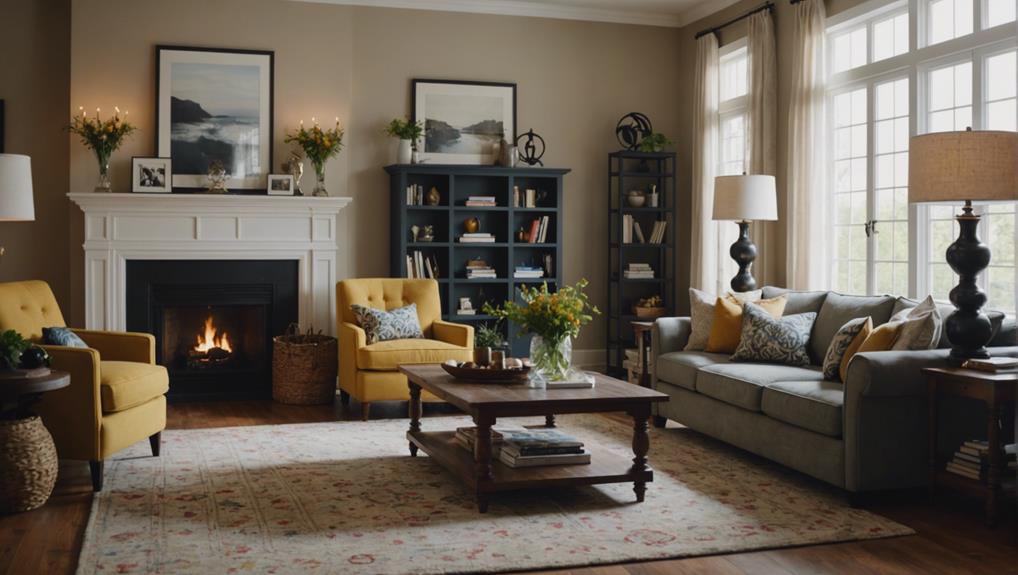Furniture selection merges design trends and historical influences, reflecting craftsmanship and style evolution from ancient civilizations to modern innovation.
Chairs, sofas, and stools add personality and functionality to living spaces. Tables, available in various materials and shapes, serve practical and aesthetic purposes. Storage solutions like cabinets, shelves, and chests keep spaces organized.
Traditional, modern, or rustic styles can transform a room’s ambiance. Exploring diverse furniture options offers possibilities to elevate living spaces with both style and functionality.
Table of Contents
ToggleHistory of Furniture
The historical origins of furniture can be traced back to ancient civilizations such as Egypt and Greece, where chairs, desks, and beds were intricately designed with luxurious materials. In ancient Egypt, furniture was crafted with intricate designs and luxurious materials. In Greece and Rome, furniture reflected the grandeur of the empires, with marble-topped tables and elaborately carved bed frames showcasing exquisite craftsmanship.
During the Renaissance period, furniture styles were influenced by the revival of classical art and architecture, leading to the creation of ornate chairs and desks adorned with elaborate motifs. The Baroque and Rococo eras brought about a shift towards more extravagant and decorative furniture pieces, such as intricately carved bed frames and lavish seating options.
In the 19th century, industrialization made furniture production more accessible, leading to the mass production of chairs, desks, and beds. This accessibility paved the way for a wider range of styles and designs to cater to different tastes and preferences. Today, furniture design continues to evolve, blending traditional craftsmanship with contemporary trends to offer a diverse selection of chairs, desks, and beds for modern living spaces.
Ancient furniture
Ancient furniture from civilizations like Egypt, Greece, and Rome features intricate designs and skilled craftsmanship, utilizing materials such as wood, stone, and metal to explore cultural beliefs and values. Carvings and embellishments on these pieces served practical and symbolic purposes, with thrones symbolizing power and status in royal courts.
Each region had unique styles with specific artistic elements and decorative motifs representing cultural identity. Preservation of ancient furniture enables investigation of historical design trends, construction techniques, and societal norms, offering valuable insights into the past.
Studying these pieces provides a deeper understanding of craftsmanship, artistry, and symbolism in early civilizations.
Medieval furniture
Medieval furniture during the Middle Ages showcased intricate design aesthetics, emphasizing durability and longevity. Common materials like oak, walnut, and chestnut wood were utilized. Furniture often featured intricate carvings, decorative motifs, and symbolic designs representing religious or royal themes. Chairs, tables, chests, and beds were staple pieces, combining functionality with artistic embellishments. Influenced by styles such as Gothic, Romanesque, and Renaissance, medieval furniture fused architectural elements and expert craftsmanship.
- Medieval chairs had high backs and intricate carvings for comfort and visual appeal.
- Tables had detailed legs and tabletop carvings, serving as focal points in living spaces.
- Chests were used for storage, adorned with elaborate metalwork and carvings showcasing wealth and status.
- Bed frames often had canopy tops and ornate carvings.
- Each piece of medieval furniture was a tribute to skilled artisans, blending functionality with artistic expression.
Modern furniture
Modern furniture diverges from medieval furniture with its clean lines, sleek designs, and minimalistic aesthetics. Common materials in modern furniture include metal, glass, and leather for a contemporary look. Bold colors or monochromatic palettes are often used to create a stylish environment. Functionality is a key aspect of modern furniture design, focusing on practicality and efficiency.
In modern furniture, a sleek sofa can serve as the focal point of a living room, exuding elegance and comfort. Pair it with a minimalist coffee table to create a chic and functional space for relaxation or entertainment. An armchair with clean lines and a pop of color can add personality to a modern living space. Modern furniture pieces can transform a home into a stylish haven that reflects contemporary taste.
Types of Furniture
Furniture types include sofas, chairs, tables, beds, and storage units. Each serves specific functions in a room. Key furniture types to explore are:
- Couch: A staple piece for lounging and relaxation, the couch is a focal point in a living room, offering comfort and style.
- Nightstand: An essential beside furniture item, the nightstand provides a surface for bedside lamps, books, or other nighttime essentials.
- Bookcase: Ideal for organizing and displaying books, decor items, and personal belongings, a bookcase adds functionality and aesthetic appeal to a room.
- Table: Whether a coffee table in the living room or a dining table in the kitchen, tables provide surfaces for various activities and gatherings.
- Storage Unit: From cabinets to shelves, storage units help declutter and organize a space effectively, keeping items out of sight yet easily accessible.
Seating
When considering seating options for a living space, the choice of furniture types significantly impacts comfort and functionality. Upholstered chairs offer comfort and style, suitable for living rooms and dining areas. Modular sofas provide flexibility in layout arrangements. Benches are versatile seating options for dining tables or entryways, adding character to a space. Below is a comparison table for visualization:
| Ottoman | Loveseat | Bench |
|---|---|---|
| Versatile | Cozy | Flexible |
| Footrest | Two-seater | Seating |
| Extra storage | Intimate | Entryway seating |
| Accent piece | Small space friendly | Multi-functional |
Selecting the right mix of seating options can enhance the overall aesthetic and functionality of your living space.
Chairs
Explore various chair styles to enhance your living space. Consider design, material, and comfort for functionality and aesthetic appeal. Key chair types include armchairs, recliners, dining chairs, upholstered chairs, and swivel chairs.
Armchairs add elegance and comfort, ideal for creating cozy reading nooks. Recliners offer luxurious relaxation options, from modern to traditional styles. Dining chairs come in diverse shapes and materials to personalize your dining area. Upholstered chairs add warmth, texture, and color while ensuring comfort. Swivel chairs provide flexibility and movement for multitasking or socializing.
Sofas
Sofas are essential furniture pieces that provide seating and style to living spaces. Factors to consider when selecting a sofa include size, style, fabric, and functionality. Designs such as sectional, loveseat, sleeper, or reclining sofas cater to different needs.
Quality sofas feature sturdy frames, high-density foam, and durable upholstery materials for longevity and comfort. A well-chosen sofa can serve as a focal point in a room, enhancing the overall aesthetic appeal. Pairing the sofa with complementary furniture like a cabinet or end table can create a cohesive look.
Stools
Stools offer versatile seating options for living spaces, catering to different needs and preferences. They come in various heights, styles, and materials to complement your decor.
Stools can function as additional seating, side tables, or decorative accents. Consider the intended use, design aesthetic, and adjustable height for flexibility in different settings.
Tables
Tables are essential furniture pieces in a living space, serving both functional and aesthetic purposes. They come in various shapes and sizes, such as dining tables, coffee tables, and console tables, each with a specific intended use.
Dining tables are meant for meals and gatherings, while coffee tables often act as a central piece in seating areas. Console tables are ideal for displaying decor or offering storage in narrow spaces. Common materials used in table construction include wood, glass, metal, and marble, each providing a unique appearance.
Tables can serve as focal points or seamlessly blend with existing decor to enhance the overall style and proportions of a room. Choosing a table that complements the space’s design and purpose can elevate the ambiance of the living area.
Dining tables
Dining tables come in various shapes and sizes to fit different room layouts and personal preferences. Consider the shape, material, and size when choosing a dining table to ensure it complements your space effectively.
Look for round, square, rectangular, and oval shapes to match your room layout and personal style. Choose between wood, glass, or metal dining tables based on durability, maintenance requirements, and aesthetic appeal.
Opt for extension dining tables to accommodate extra guests during gatherings effortlessly. Consider pedestal dining tables for smaller spaces, offering more legroom and a streamlined appearance.
Ensure your dining table falls within the typical height range of 28 to 30 inches for comfortable seating and dining experiences. When styling your dining area, complement your table with furniture pieces like buffets, hutches, or sideboards for added storage and visual interest.
Coffee tables
Coffee tables are available in various shapes including round, square, rectangular, and oval, offering versatility to complement different room layouts and personal preferences. Materials such as wood, glass, metal, and stone provide diverse choices, each with unique aesthetic appeal, durability, and maintenance requirements.
Consider features like storage compartments, lift tops, or nesting designs when selecting a coffee table for added functionality in your living area. Ensure the height of the coffee table aligns well with your seating arrangement for comfort and visual harmony in the room. The style of the coffee table, whether modern, traditional, industrial, or eclectic, significantly impacts the overall design aesthetic of the space.
Some coffee tables also feature a shelf underneath for storing books or magazines, making them a practical addition to your living room alongside other furniture like a chaise lounge or an armoire.
Desks
Desk selection for your workspace should consider style, size, and storage options. Desks are available in traditional, modern, and industrial styles. Ensure the desk fits well in your workspace for efficient workflow.
Look for desks with storage options like drawers, shelves, or compartments for organization. Adjustable height desks offer flexibility for standing or sitting work positions, promoting better posture.
Opt for desks made of durable materials like solid wood, metal, or high-quality laminate for long-lasting functionality and aesthetics.
C. Storage
Utilize furniture pieces with built-in storage options like wardrobes, chest of drawers, and bed frames with drawers to maximize space efficiency.
Wardrobes offer ample space for hanging clothes and shelves for folded items.
Chest of drawers are optimal for storing smaller clothing items or accessories, keeping them organized.
Bed frames with drawers underneath are ideal for storing extra linens, clothing, or other items, maximizing space in your bedroom.
Cabinets
Cabinets, available in various sizes, styles, and materials, can be customized to meet specific storage needs and design preferences. They offer organized storage solutions for different items in kitchens, bedrooms, and other areas of the home. With features like shelves, drawers, doors, and customizable hardware options, cabinets can adapt to various storage requirements and aesthetic preferences.
When selecting cabinets, consider factors like material durability, finish, design style, and dimensions to ensure they harmonize with the overall room design. Cabinets can serve multiple purposes beyond storage, such as functioning as a credenza in the dining room, a futon in the living room, or even a headboard in the bedroom.
Shelves
Shelves provide vertical storage solutions in living spaces, organizing items and adding decorative elements. They hold books, decor, and essentials, keeping them accessible and maintaining a clutter-free environment.
Floating shelves offer a minimalist aesthetic, easy installation without visible brackets, and a modern look. Built-in shelves seamlessly blend with the room’s design, offering customized storage solutions.
Adjustable shelves accommodate items of different heights and sizes, providing flexibility. Corner shelves maximize space efficiency by utilizing overlooked corners.
Incorporating shelves enhances functionality and creates a stylish, organized atmosphere.
Chests
Chests are versatile furniture pieces that offer both storage and style options for various rooms like the living room, bedroom, or entryway. They come in materials such as wood, metal, or wicker to match your design preferences and existing furniture.
Some chests feature intricate designs and detailing, adding elegance to your space. Consider the dimensions and storage capacity of the chest to ensure it fits well in your room and provides adequate storage space to meet your organizational needs without overcrowding the room.
Materials Used in Furniture
Wood is a durable, versatile, and aesthetically pleasing material commonly used in furniture crafting.
Metal, like steel and aluminum, is utilized in modern and industrial furniture for its strength and sleek appearance.
Upholstered furniture often incorporates fabrics such as linen, cotton, and leather for comfort, style, and easy maintenance.
Plastic furniture, known for its lightweight nature, affordability, and easy cleaning, is suitable for both outdoor and contemporary indoor settings.
Glass is employed in furniture design for its transparent and reflective qualities, adding elegance and modernity to pieces.
Understanding the characteristics and benefits of these materials aids in informed decision-making when selecting furniture to complement living spaces.
Wood
Wood is a durable and versatile material extensively used in furniture making. Various types of wood, like oak, pine, and mahogany, offer distinct characteristics and aesthetics. Solid wood furniture is renowned for its enduring nature and ability to be refinished repeatedly.
Engineered wood products, such as plywood and MDF, provide economical and stable furniture alternatives. Adequate maintenance is crucial to preserve the beauty of wood furniture and shield it from damage caused by moisture or sunlight.
Metal
Metal furniture, made from durable materials like steel, aluminum, and iron, enhances living spaces with a sleek and modern aesthetic. Its versatility allows for indoor or outdoor placement, making it a practical choice for various settings.
Metal furniture is easy to maintain, requiring only a quick wipe-down to keep it looking pristine. It can be styled in numerous ways to complement different interior design schemes, from contemporary to industrial. Mixing metal pieces with other materials like wood or upholstery offers endless opportunities for creating personalized living spaces.
Metal furniture brings sophistication and modern flair to any home.
Plastic
Plastic furniture is a popular choice for many homeowners due to its advantages, including convenient mobility, affordability, durability, modern designs, and easy maintenance. Plastic furniture is lightweight and easy to move around, making it convenient for changing room layouts. It’s often more affordable compared to other materials, offering budget-friendly options for furnishing spaces.
Plastic furniture is durable and resistant to moisture, making it suitable for outdoor use or high-traffic areas. Modern advancements in plastic manufacturing have led to stylish and contemporary designs in furniture. Cleaning plastic furniture is simple and straightforward, requiring minimal maintenance for long-lasting use.
Plastic furniture is a practical, durable, and affordable option for furnishing living spaces, providing functionality and style.
Glass
Glass furniture enhances the aesthetic appeal of living spaces with modern design. Its transparent nature creates an illusion of more space, ideal for smaller rooms. Glass tables and shelves blend seamlessly with various design styles.
Tempered glass is durable and safe, breaking into small, dull pieces. Cleaning is easy with a glass cleaner.
Glass furniture reflects light and adds elegance, a stylish choice for modern living spaces.
Furniture Styles
Various furniture styles, such as Modern, Contemporary, Traditional, Rustic, and Industrial, offer distinct characteristics in design, materials, and finishes. Modern style features clean lines and minimalist design with metal and glass elements.
Contemporary style reflects current trends with fluid lines and a mix of materials like wood, metal, and leather. Traditional style is classic and elegant, showcasing ornate details, rich woods, and luxurious fabrics. Rustic style embodies a natural and cozy feel with raw wood, earthy tones, and textures like leather and wool.
Industrial style is urban and edgy, combining metal and wood elements, often with a distressed finish. Understanding these styles is crucial for achieving a cohesive interior design scheme that reflects individual tastes and preferences. Mixing furniture styles can add personality and visual interest to a space, while selecting a consistent style enhances the overall ambiance and aesthetic appeal of a room.
Traditional
Traditional furniture is characterized by enduring pieces with intricate woodwork and ornate details. Rich color palettes like deep reds, browns, and greens are commonly used, creating a warm atmosphere.
Traditional style features formal and elegant pieces such as wingback chairs, roll-arm sofas, and pedestal dining tables, embodying sophistication and craftsmanship.
This furniture brings a sense of history and charm to living spaces, making them cozy and inviting.
Modern
Modern furniture design emphasizes clean lines, simplicity, and functionality. Key features include the use of materials like glass, metal, and leather, sleek finishes, and geometric shapes.
Neutral color palettes with bold pops of color, innovative storage solutions, and multi-purpose usage are common. Contemporary design elements are integrated to provide a cutting-edge appeal.
Consider these aspects when selecting modern furniture to create a sophisticated and stylish atmosphere in your home.
Rustic
Rustic furniture design incorporates natural elements like wood, stone, and earthy tones to create a cozy ambiance in your living space. This style features distressed finishes, reclaimed wood, and vintage-inspired accents, evoking a warm and charming look.
Farmhouse tables, barn doors, leather sofas, and wrought iron details are common in rustic furniture, adding character and countryside charm to your home. Mixing rustic pieces with modern elements creates a stylish fusion of old-world allure and contemporary flair.
Transform your living space into a welcoming retreat with rustic furniture, infusing warmth and coziness for a relaxed atmosphere.
Industrial
Industrial furniture combines metal and wood to create a utilitarian aesthetic in modern living spaces. This style prioritizes functionality and durability, featuring metal accents, weathered textures, and minimalist designs inspired by old factories and warehouses.
Industrial furniture often includes elements like exposed pipes, distressed finishes, and salvaged items, adding an edgy touch to the decor.
Furniture Design Process
The furniture design process involves multiple steps:
- Conceptualizing ideas and sketching designs
- Refining designs for functionality
- Considering ergonomics and selecting sustainable materials
- Exploring production techniques
- Using CAD software for visualization and prototyping
- Collaborating with stakeholders for alignment
- Implementing iterative feedback loops and revisions
These steps ensure the desired level of quality and functionality in the final product.
Conceptualization
Furniture conceptualization begins by visualizing the desired atmosphere and establishing a design theme for the living space. Reflecting on personal preferences and considering the room’s intended use are crucial factors during this phase.
It’s essential to ensure that the functionality of the furniture aligns with the aesthetic appeal, guaranteeing a cohesive and inviting environment. By carefully considering these aspects, we can make furniture choices that not only look good but also effectively serve our practical needs.
Sketching
Sketching furniture layouts is essential for effective space planning. It helps visualize placement, experiment with configurations, and optimize space usage.
3D Modeling
3D modeling offers a transformative tool for furniture selection and room design, revolutionizing living spaces. Key benefits include:
- Realistic visualization
- Accurate dimensions for precise measurements
- Virtual experimentation for layout exploration
- Design complement for style coordination
- Enhanced decision-making through detailed previews of furniture setups
This empowers informed choices for creating harmonious and well-designed living spaces.
Prototyping
Prototyping in furniture design allows designers to test functionality and aesthetics through scaled models or mock-ups, ensuring that the final products meet desired specifications.
Creating prototypes helps designers visualize concepts in a tangible form, aiding in identifying design flaws, ergonomic issues, or structural challenges early on.
Adjustments can be made to enhance quality, usability, and appeal before production, leading to well-crafted furniture pieces that align closely with the original vision and meet user needs.
Successful prototyping contributes to the creation of aesthetically pleasing and efficient furniture designs.
Production
Wood, metal, fabric, and leather are vital materials used in furniture crafting. The production process includes cutting, shaping, assembling, and finishing.
Sustainable furniture production emphasizes eco-friendly materials and responsible sourcing. Customization enables personalized designs, sizes, and finishes to meet specific preferences.
Mass production efficiently meets market demands on a larger scale.
Importance of Furniture in Interior Design
The selection of furniture significantly influences the ambiance and functionality of interior spaces. Furniture choice sets the tone and style of a room, serving as a fundamental element in interior design. Thoughtfully selected furniture can elevate the overall design scheme, adding durability and aesthetic appeal to living spaces.
Properly scaled furniture is essential for maintaining balanced room proportions, ensuring harmonious and well-designed space. Strategic placement of furniture enhances room functionality and creates a visually appealing environment. Understanding the importance of furniture in interior design transforms living spaces into inviting and well-designed areas that serve their intended purpose effectively.
Functionality
When choosing furniture, prioritize functionality over aesthetics to meet specific lifestyle needs effectively.
Here are five essential points to consider:
- Invest in purposeful pieces: Opt for furniture that enhances usability by fulfilling specific needs.
- Prioritize storage solutions: Choose furniture with built-in storage to declutter and organize the space.
- Select comfort for activities: Opt for comfortable pieces tailored to activities in the space.
- Ensure efficient functionality: Prioritize furniture that serves its intended purpose effectively, making daily tasks more convenient.
- Balance functionality with visual appeal: Seek furniture that combines functionality and aesthetics to enhance the overall living experience.
Aesthetics
Enhancing the aesthetics of your living space involves considering the color palette, texture, and design style of furniture. Incorporating furniture with unique features like handcrafted details or artistic elements can create a visually appealing room that reflects your personal style.
Achieving a harmonious look requires balancing the visual weight of furniture pieces by mixing different shapes, sizes, and materials. Opting for furniture with elegant finishes or decorative accents adds sophistication and charm to your interior design.
Experimenting with bold patterns, luxurious fabrics, and statement pieces can elevate the aesthetic appeal of your living space. These elements add depth and visual interest, making your room welcoming and stylish.
Thoughtfully curating furniture pieces with attention to detail can transform a mundane space into a showcase of beauty and creativity.
Space utilization
Maximizing space efficiency involves choosing furniture with integrated storage solutions. To optimize your living area, prioritize multifunctional pieces like sofa beds or nesting tables for versatility.
Utilize vertical storage options such as shelves or wall-mounted cabinets to save floor space. Make the most of underutilized areas like corners or alcoves with custom-built furniture.
Incorporate furniture with adjustable components like extendable dining tables or modular shelving units for adaptable layouts. Consider furniture with hidden storage compartments to maintain a clutter-free and organized space.
How to Choose the Right Furniture
To ensure your furniture selection complements your living space effectively, carefully assess the functionality, quality, style, and dimensions of each piece. Consider how each furniture piece will serve your specific needs and lifestyle requirements. Evaluate the materials and construction of the furniture to ensure durability and long-term satisfaction.
Pay attention to the style and design to confirm it aligns with your interior design scheme and personal preferences. Taking accurate measurements of your space is vital to select furniture that fits well and maintains proper proportions. Balance and proportion play a significant role in creating a visually appealing and harmonious living space.
Focus on functionality, quality, style, and dimensions to choose furniture that meets your needs and enhances the aesthetics of your home. Remember, the key is to balance these aspects for a well-rounded furniture selection.
Assessing your space
Assess available space for furniture placement by accurately measuring room dimensions.
Consider existing architectural features like doorways and windows, traffic flow, and clearance requirements for functional placement.
Evaluate natural lighting, room layout, and overall ambiance to guide furniture positioning effectively.
Determining your style
Determining the interior design style that best suits our living space involves reflecting on personal style preferences such as modern, minimalist, traditional, or rustic.
Creating a mood board with inspiring images and colors helps establish a cohesive design direction.
Identifying design elements we enjoy, like clean lines, natural materials, bold colors, or vintage accents, guides furniture choices.
Consistency is crucial in the interior design scheme, so incorporating furniture that reflects and enhances our chosen style is key.
Understanding our style preferences and aligning furniture choices with them ensures a harmonious living space that reflects our unique taste and personality.
Considering your lifestyle
Considerations for Selecting Furniture
- Comfort: Choose furniture that aligns with your daily space usage.
- Functionality: Prioritize pieces that serve a purpose in your routine.
- Durability: Opt for materials that can withstand wear and tear.
- Hobbies Support: Select furniture that accommodates your interests.
- Enhance Living Space: Ensure chosen furniture fits your lifestyle and enhances your home’s ambiance.
Budgeting
Establishing a realistic budget aligned with your needs is crucial for effective financial management when choosing furniture. Prioritize essential furniture items based on importance to maintain financial discipline.
Stick to predetermined budget limits to make informed choices and avoid overspending. Focus the budget on significant items like sofas or tables to ensure a well-balanced living space.
Remain flexible with the budget for accessories and décor to enhance the overall look within financial constraints.
Furniture Maintenance and Care
To ensure the longevity and visual appeal of your furniture, follow these essential maintenance tips:
Regularly dust and clean furniture to prevent dirt and grime buildup. Use appropriate cleaning products for specific materials.
Rotate cushions and pillows to promote even wear and maintain shape.
Address spills and stains promptly to prevent permanent damage.
Follow manufacturer’s care instructions to preserve quality and appearance.
Cleaning
Regular cleaning of furniture is essential to maintain longevity and visual appeal. Using appropriate cleaning products for specific materials is vital to prevent unintentional damage. Upholstered furniture should be vacuumed regularly to remove dust and debris.
Wooden furniture should be wiped down with a damp cloth to preserve shine and condition. Dusting all furniture surfaces weekly helps prevent grime buildup and maintains a clean appearance.
Prioritizing these cleaning practices ensures the extended lifespan of furniture pieces.
Repair
Furniture repair is essential to maintain its condition and extend its lifespan. Here are key points to consider:
- Regular maintenance prevents small issues from becoming major problems.
- DIY repair kits and tutorials are useful for minor damages like scratches and dents.
- Professional repair services can address complex issues such as structural damage or upholstery repair.
- Promptly fixing loose joints prevents further damage and ensures stability.
- Restoring finishes revitalizes furniture’s appearance and protects it from wear and tear.
Preservation
To preserve furniture, it’s essential to follow the manufacturer’s care instructions. Using coasters, placemats, and tablecloths can help prevent scratches, watermarks, and stains. Avoid placing furniture in direct sunlight to prevent fading and deterioration.
Regular cleaning and dusting can maintain the furniture’s appearance and prevent dirt buildup. For antique or valuable pieces, consider professional restoration services to maintain authenticity and value.
Future Trends in Furniture
In the realm of furniture design, several key trends are shaping the future of living spaces:
- Sustainable materials like bamboo and recycled plastic are gaining popularity, driven by increased eco-consciousness.
- Smart furniture featuring technology such as built-in chargers and adjustable features is on the rise, enhancing modern living convenience.
- Modular and customizable furniture options are becoming more prevalent, offering greater flexibility and adaptability in various living spaces.
- Biophilic design, incorporating natural elements like plants and natural light, is influencing furniture aesthetics, bringing a touch of the outdoors inside.
- Multi-functional furniture designs are becoming prominent, catering to the shift towards remote work and flexible living arrangements, optimizing space utilization and functionality.
Sustainable furniture
Sustainable furniture, made from eco-friendly materials like reclaimed wood, bamboo, or recycled metals, reduces carbon footprint, supports ethical practices, and promotes resource conservation. These materials minimize environmental impact by reducing deforestation, energy consumption, and waste generation.
Sustainable furniture often features non-toxic finishes, organic fabrics, and responsible manufacturing processes. To ensure sustainability, look for certifications like FSC (Forest Stewardship Council) or GREENGUARD.
Smart furniture
Smart furniture integrates advanced technology for enhanced functionality and convenience in modern living spaces. This furniture surpasses traditional pieces with features like built-in charging stations for powering up devices conveniently and adjustable settings controlled via apps for personalized comfort.
Automation features enhance efficiency in various tasks, and customization options allow tailoring to specific needs. Examples include smart beds with sleep tracking capabilities and smart desks with height adjustment options, showcasing the diversity of smart furniture available.
Investing in smart furniture can transform your home into a modern, tech-savvy environment that adapts seamlessly to your lifestyle, blending technology with furniture design to create a space that functions innovatively to enhance daily life.
Minimalist furniture
Minimalist furniture features clean lines, uncluttered designs, and neutral colors to enhance living spaces. Common materials like metal, glass, and wood are used to create simple and sophisticated pieces. This style emphasizes space and functionality, often incorporating multi-functional elements like storage beds or modular sofas.
Implementing the right furniture can significantly impact your home’s functionality, aesthetics, and overall ambiance. Key takeaways include:
- Considering style, size, and functionality of furniture pieces.
- Prioritizing space planning for a balanced living environment.
- Selecting durable and visually appealing fabrics.
- Investing in high-quality furniture for long-term satisfaction.
- Finding pieces that fit your budget without compromising style or quality.
Recap of key points
When choosing furniture for your living space, consider your personal style and desired ambiance. Ensure the size and proportion of the furniture complement the room’s dimensions.
Prioritize functionality alongside aesthetics to guarantee each piece serves a purpose while enhancing the overall look. Space planning is crucial for optimizing layout and flow, creating a harmonious environment.
Fabric selection impacts the look, feel, and durability of the furniture pieces. By keeping these key points in mind, you can make informed decisions to elevate the style and functionality of your living space, reflecting your unique taste and preferences.
Final thoughts on the importance and evolution of furniture
The evolution of furniture’s significance in shaping living spaces is closely tied to changing design trends and lifestyle needs. Quality furniture plays a pivotal role in enhancing both aesthetics and functionality, offering practical purposes in a room while reflecting our habits and routines.
Well-selected furniture has the power to transform the ambiance of a space, making it more inviting and comfortable. Investing in furniture can increase the value of your home and contribute to a higher quality of life by creating a unique and personalized living environment.





